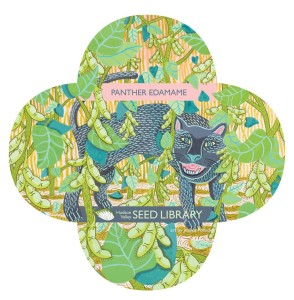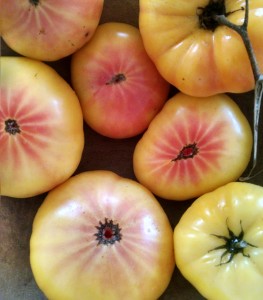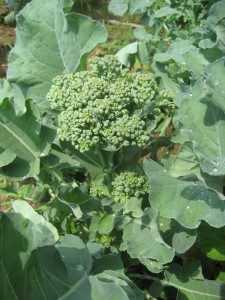Hudson Valley Seed Library
It’s that time of year again. Time to buy seeds, either at your local feed-and grain store, the local garden center, or from a catalog. I like to buy locally, but catalogs do present a wider variety than most stores can offer. Recently I called Ken Greene, founder of the Hudson Valley Seed Library in Eastern New York State, to have a chat about seeds.
The Hudson Valley Seed Library (www.seedlibrary.org) is a bit different than most seed companies. It was started in 2004 by Ken Greene to make locally grown seeds available to gardeners in his region, and to keep old local varieties from disappearing. He wanted to develop strains that are particularly good in the northeast, and to teach gardeners how to save seeds themselves.
Ken was afraid that the big companies would take over the seed market with genetically modified seeds (GMO’s), though that fear seems not to have materialized. Most seed companies refuse to sell GMO’s, though many farmers use them to grow grains and cotton.
Ken is a self-taught gardener. His education is in special education, but when he was working part-time in a library he offered patrons some seeds that he had grown. Take some seeds, he told them, grow them out and then bring some back for next year. He taught the patrons how to save seeds properly. It was sort of a slow-moving seed swap and no money changed hands. It was a big success, so in 2008 Ken quit his day job and started his seed company. He kept the same name he had used when he started, Hudson Valley Seed Library.
Most large seed companies contract with farmers to produce the seeds they sell in colorful little paper packages. Although a hundred years ago New England boasted many seed companies that produced seeds for local use, now there are just a handful of companies based here. Our summers are short, and often high in humidity which can encourage fungal diseases, so even local companies generally develop and test their varieties here in New England, but then send seeds to growers elsewhere for mass production. Idaho, New Mexico and other hot, dry areas are prime seed-growing areas. Hudson Valley grows its seed in New York and New England, much of it on Ken’s farm in Accord, NY.
Hudson Valley only sells open pollinated varieties, those that will breed true, year after year. You can save seeds from these. I save seeds from my favorite heirloom tomatoes every year, as they are open pollinated. Each tomato has both male and female parts, and they can be wind or insect pollinated. Heirloom just means that they are varieties that have been around for a long time – generally 50 years or more.
Some heirloom vegetables are open pollinated, but are susceptible to inadvertent crosses by insect or wind pollination. Cucumbers, squash and pumpkins are easily cross pollinated, resulting in those weird monsters that sometimes show up in your compost pile. If you want to save seed from the vine crops, you (and your neighbors) need to separate varieties by a quarter of a mile or more, or protect the blossoms from insects and hand pollinate blossoms yourself. Hudson Valley has a membership program that offers education to its members about seed saving, and opportunities to test new lines of seed.
I asked Ken about some of his favorite open pollinated varieties. He suggested that I try his New York Early Onion. He said most gardeners don’t bother starting onions from seed, but that this one is a great onion that keeps well and is worth the time and effort. You should start these indoors in flats anytime from mid-February to late March – and I will.
A great container tomato, Ken said, is Summer Sunrise. It’s a small plant but produces full-sized salad tomatoes on sturdy stems, and has great heirloom flavor. He also likes growing ground cherries, a relative of tomatoes that taste like ”pineapple, citrus and tomato”. They are not ripe until they fall off, so you harvest them by picking them up off the ground. Each comes wrapped in a husk – to keep the fruit clean! I’ve grown them, but not recently, and might try some again.
One of my favorites from Hudson Valley is Piracicaba, a broccoli relative that only produces what, in a standard broccoli, we would call side-shoots. No big head. But Piracicaba is very productive and very tasty. It continues to produce long into the fall, too.
I will also try Hank’s Xtra Special Baking Beans. I’ve always found that dry beans are a lot of work to clean and get ready to use, but Ken gave me his method, which I like: let bean pods dry in the field, then pull them. Hang the plants in a hoop house or barn until the pods are brittle. Then beat the plants against the inside of a clean 30-gallon trash can to knock the beans loose, avoiding the task of shelling. To get rid of the extraneous material, set up a box fan so that it can be blown away as you empty the trash can into a bucket. Slick!
There is nothing wrong with buying hybrids or modern varieties, though I do find many of the old open-pollinated heirlooms offer wonderful flavors I could never find in the grocery store. So I grow both, and maybe you should, too.
Henry has been a UNH Master Gardener since 1998 and is the author of 4 gardening books. His website is www.Gardening-Guy.com.





